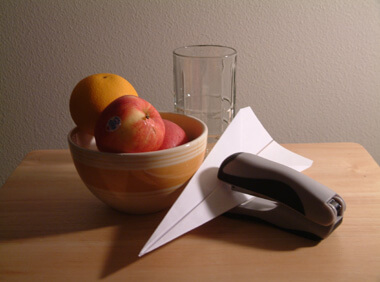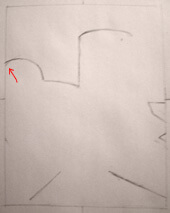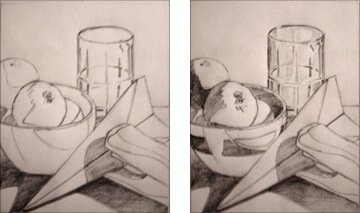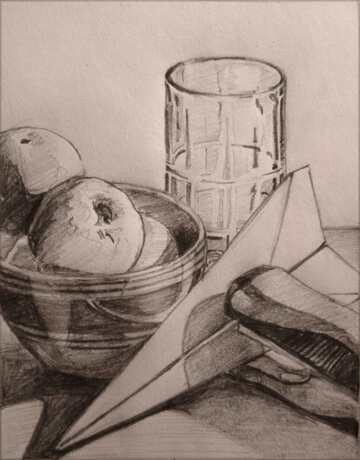Drawing What You See Vs Drawing What You Know
This commodity contains step-by-footstep images of the process I utilise to create realistic looking drawings, as well equally tips I've picked up over the years which anyone can utilise to amend their cartoon skills. It's essentially a quick version of our 55+ page drawing course, How to Draw EXACTLY What Y'all Meet.
There's a lot to embrace, so permit's get started!
Quick declaration - EmptyEasel has created a quicker, easier way for artists to accept their own fine art website. Click hither to learn more than and get a elementary art website of your own!
1. Make certain in that location's a directly lite source.
Earlier I started on the drawing for this tutorial, the first thing I did was set up a lamp pointing at my all the same life from just a few feet away. I also turned off all the other lights in the room to increase contrast and clarify each shadow.

Information technology's extremely important to make expert lighting for yourself when y'all're cartoon indoors. If you don't have that stiff directional light, you won't be able to see the shadows and highlights and your cartoon will nearly probable turn out gray and visually flat.
2. Use a viewfinder to fix your composition.

Store-bought viewfinders piece of work too—here are several from Blick if you desire something a bit sturdier and longer-lasting. I'm just inexpensive. :)
Move the viewfinder around until you've found the best composition possible and tape it in place. Then draw the same size of rectangle on your paper.
When you look through the viewfinder, everything inside the frame is what you'll depict, and y'all tin can ignore the rest. Not only will it ameliorate your compositions, but information technology will as well help with the next few steps in the drawing process.
Last on this point, here is another example of a viewfinder pulled straight from our course How to Draw Exactly What You See

If you don't have one, I highly propose picking i upwards. You can get the ane in the photo at this DickBlick link.
3. Start drawing objects that intersect the edge.
Always brainstorm drawings along the edges first, before you exercise anything else. This will "ballast" your drawing in place and keep you lot from running out of space afterwards on.

You can't encounter those marks on the viewfinder higher up, but on the paper to the left I've put red arrows to bear witness where they are.
These marks give me smaller distances to mensurate between when I'm staring at my blank paper trying to effigy out where along the edges I should begin.

If I hadn't had that mark, it would have been a lot harder to make up one's mind exactly where to draw the line.
(This thought is similar to using a grid, except there aren't whatever lines running across the picture.)
4. Bank check line angles with your pencil.

This is a groovy way to go right perspective lines, edges of buildings, or anything, really. No thing what I'thousand cartoon this technique often comes in handy. Simply brand certain that yous don't subconsciously modify the angle of your pencil to match your drawing.
5. Work around each border and then move inward.

While you lot practise this, you'll generally want to keep moving all around the paper then that whole drawing progresses evenly. At this point in the drawing you should only be putting down the main outlines—no details or shading!
Depict lightly likewise. When you get to tip #9 yous'll see why it's a good idea.
six. Draw the negative space around the objects.

by Betty Edwards. It's stuck with me through the years and I utilise it every fourth dimension I draw.
What you do is, instead of trying to draw a bowl or fruit, draw the negative shapes between objects instead. Does that make sense?
The problem with just thinking "draw that orangish," is that your mind will bring up non-visual ideas most oranges instead of letting you focus on the specific shapes in front of you lot.
seven. Close ane center to flatten out the image.
I always squint with one center when I describe, and I'k sure many of you do as well. This helps because it eliminates depth perception and makes the subject area you lot're drawing appear flat. Be consequent in which centre yous utilise, though; if you switch optics you'll see the objects move slightly, which can mess yous upward.
eight. Await dorsum and forth as oftentimes as possible.

So when you describe or paint, flick your optics back and forth and never let them residuum for too long in ane identify.
With practise, your eyes will do this naturally, but it'due south important if you're only starting out to practise it purposefully at get-go to build upward the habit.
ix. Erase when yous see something wrong.
Don't only leave your mistakes there—set them! If y'all can encounter a trouble early on, your finished drawing will have it too. By so you lot won't want to go all the way dorsum and change everything, and then get it correct before you're too far in.
What a lot of people don't understand is that the most of import functionof any drawing is the initial line drawing. And then always erase if you need to, because once you've got a expert line drawing, you're home free.
10. Shade from darkest to lightest.

Once the line drawing is washed, beginning filling in the darkest shadows first. Call up to look for areas of reflected lite on the shadow sides of objects. Almost everything reflects low-cal at least a little bit, and leaving those areas lighter will brand your drawings much more three-dimensional. After your dark shadows are done, begin to work on the lighter tones all the way up to white.
11. Include a full range of values.

Having a total range of values in a cartoon looks more natural, since it's how we run into in existent life and it's is easy enough to practice by only adding more than darks or using an eraser to pull out more than highlights.
And fifty-fifty if there don't seem to be pure black or pure white areas in real life, prevarication just a little scrap and add them in anyhow; your final drawing will wait better.
12. Take a break before finishing.
When the drawing is well-nigh finished, I usually have a breather, walk around, so come up back to finish information technology.
After being away for a while, you'll be able see if there are mistakes or places that should be completed just somehow got disregarded. Fix those, and at the same time use your eraser to choice out the brightest highlights in your cartoon.

And there's the finished piece. I promise you enjoyed this tutorial; it was fun for me to simply use my expert drawing pencils for a change, instead of my normal oil paints.
For pace-by-step drawing instructions explaining how to do everything mentioned above, make sure to download our total drawing course, How to Describe EXACTLY What Y'all See. Click the link to acquire more than or download today!

Note: You may also exist interested in EE's step-by-step drawing guide for artists. Click below to larn more!

This mail may comprise affiliate links.
Source: https://emptyeasel.com/2006/11/24/how-to-draw-what-you-see-techniques-and-tips-to-improve-your-drawing-skills/
0 Response to "Drawing What You See Vs Drawing What You Know"
Postar um comentário